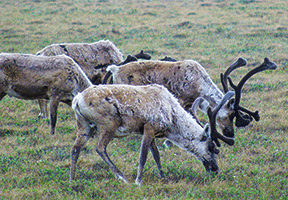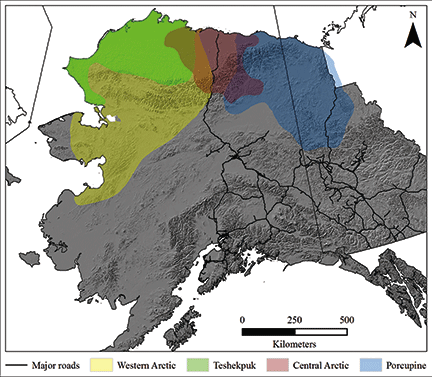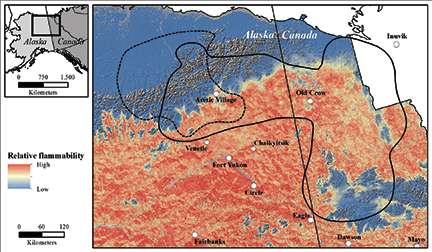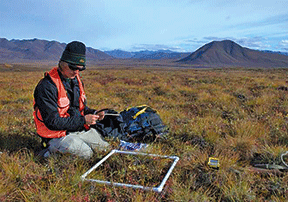Fact Sheet 2014–3103

Summer ranges for caribou are areas important for calving, replenishing resources lost during winter, and finding relief from biting insects. Why Study Caribou?The U.S. Geological Survey (USGS) Changing Arctic Ecosystems (CAE) initiative strives to inform key resource management decisions for Arctic Alaska by providing scientific information and forecasts for current and future ecosystem response to a warming climate. Over the past 5 years, a focal area for the USGS CAE initiative has been the North Slope of Alaska. This region has experienced a warming trend over the past 60 years, yet the rate of change has been varied across the North Slope, leading scientists to question the future response and resilience of wildlife populations, such as caribou (Rangifer tarandus), that rely on tundra habitats for forage. Future changes in temperature and precipitation to coastal wet sedge and upland low shrub tundra are expected, with unknown consequences for caribou that rely on these plant communities for food. Understanding how future environmental change may affect caribou migration, nutrition, and reproduction is a focal question being addressed by the USGS CAE research. Results will inform management agencies in Alaska and people that rely on caribou for food. Where Are the Caribou in Northern Alaska?Four migratory herds of caribou (Western Arctic, Teshekpuk, Central Arctic, and the Porcupine) spend summers on the North Slope of Alaska. These herds differ in total number, distribution, and population trend. Population dynamics of these caribou herds primarily are driven by “bottom up” factors, such as the influence of the environment on the plants they eat. Thus, forage availability, nutritional content, and digestibility exhibit a strong influence on annual reproduction and survival. Given the increased temperature in the Arctic, the ability of caribou populations to persist will depend on the capacity of individuals and populations to endure and reproduce in a changing ecosystem. 
Annual range map for the four migratory caribou herds in northern Alaska. How Do Changes in Plants Affect Nutrition?USGS CAE research on caribou in the Alaskan Arctic has examined how changes in the growing season and air temperature since the 1970s have affected phenology, quality, and abundance of forage plants. We have established relationships among temperature, satellite-derived indices of plant greenness, and forage characteristics that will provide the basis for understanding how caribou habitats will be affected by climate change. Integrated with the current USGS CAE research is work at the University of Alaska Fairbanks on the foraging dynamics of captive-raised caribou. Measuring how forage on different plants (shrubs, forbs, and sedges) may influence body mass and reproduction of captive caribou will allow us to develop models that can be used to forecast the nutritional implications of future habitat conditions. What Does the Future Hold for Caribou?Other future changes to northern tundra habitats include the potential for more wildfires that can alter plant composition and successional patterns. These shifts in vegetation types and characteristics alter the distribution and abundance of northern herbivores in different ways. Wildfires may benefit some species, such as moose (Alces alces) by rejuvenating habitats and increasing habitat value. However, wildfire may have negative effects on species dependent on late successional forests, such as caribou. A recent model by USGS determined that increased wildfires could reduce the production of lichens, an important winter food for caribou. 
Warming temperatures will increase the flammability of lichen-producing boreal forests, which are important winter habitat for caribou herds. Simulated relative flammability of vegetation is shown for the ECHAM5 global circulation model in the winter ranges of the Central Arctic (dashed line) and Porcupine (solid line) caribou herds, Alaska and Yukon, 2010–2100. 
Joe Welch (University of Alaska Fairbanks) collecting habitat data on the North Slope of Alaska for the Central Arctic caribou herd, September 2012. What is Next?Next steps for USGS CAE research on caribou will include the monitoring of adult females in the Central Arctic herd with high-resolution GPS collars to measure habitat use relative to temperature, forage characteristics, nutrient demands, reproduction, and seasonal changes in body mass. Additionally, an evolving GPS locational dataset from the National Park Service will be used to contrast how temperature and forage characteristics affect movements and habitat use of a rapidly declining herd in the Western Arctic and stable to declining herd in the Central Arctic. The USGS CAE research on caribou in Alaska has assisted land management agencies by projecting how climate-driven changes to vegetation may affect wildlife habitat and subsistence resources. This research is (1) summarizing how vegetation change and anthropogenic activities cumulatively affect caribou, (2) fulfilling inventory and monitoring mandates of agencies such as the National Park Service, and (3) providing information useful for conservation plans in the Arctic National Wildlife Refuge. PublicationsGustine, D.D., Barboza, P.S., Adams, L.G., and Farnell, R., 2011, An isotopic approach to measuring nitrogen balance in caribou: Journal of Wildlife Management, v. 75, p. 178–188, doi:10.1002/jwmg.11. Gustine, D.D., Barboza, P.S., Adams, L.G., Lawler, J.P., Arthur, S., Parker, K.L., and Shults, B., 2012, Diversity of nitrogen isotopes and correlates of protein status in caribou—Implications for monitoring northern ungulates: Journal of Mammalogy, v. 93, p. 778–790, doi:10.1644/11-MAMM-A-164.1. Gustine, D.D., Barboza, P.S., Adams, L.G., and Wolf, N.B., 2014, Environmental and physiological influences to δ15N and protein status in a montane ungulate in winter: PLOS One, v. 9, no. 8 e103471, doi:10.1371/journal.pone.0103471. Gustine, D., Barboza, P., Addison, J., Shively, R., and Oliver, L., 2014, Isotopic N in fecal fiber as an indicator of winter diet in caribou and muskoxen: Rapid Communications in Mass Spectrometry, v. 28, p. 625–634, doi:10.1002/rcm.6825. Gustine, D.D., Barboza, P.S., Lawler, J.P., Arthur, S., Shults, B., Persons, K., and Adams, L.G., 2011, Characteristics of foraging sites and protein status in wintering muskoxen—Insights from isotopes of nitrogen: Oikos, v. 120, p. 1546–1556, doi:10.1111/j.1600-0706.2011.19215.x. Gustine, D.D., Brinkman, T., Lindgren, M., Schmidt, J.I., Rupp, T.S., and Adams, L.G., 2014, Climate-driven effects of fire on winter habitat for caribou in the Alaskan-Yukon Arctic: PLOS One, v. 9, no. 7 e100588, doi:10.1371/journal.pone.0100588. Tape, K.D., and Gustine, D.D., 2014, Capturing migration phenology of terrestrial wildlife using camera traps: BioScience, v. 64, p. 117–124, doi:10.1093/biosci/bit018. |
First posted October 17, 2014 For additional information, contact: Part or all of this report is presented in Portable Document Format (PDF). For best results viewing and printing PDF documents, it is recommended that you download the documents to your computer and open them with Adobe Reader. PDF documents opened from your browser may not display or print as intended. Download the latest version of Adobe Reader, free of charge. More information about viewing, downloading, and printing report files can be found here. |
Gustine, David, Adams, Layne, Whalen, Mary, and Pearce, John, 2014, Changing Arctic Ecosystems—Resilience of caribou to climatic shifts in the Arctic: U.S. Geological Survey Fact Sheet 2014–3103, 2 p., https://dx.doi.org/10.3133/fs20143103.
ISSN 2327-6932 (online)